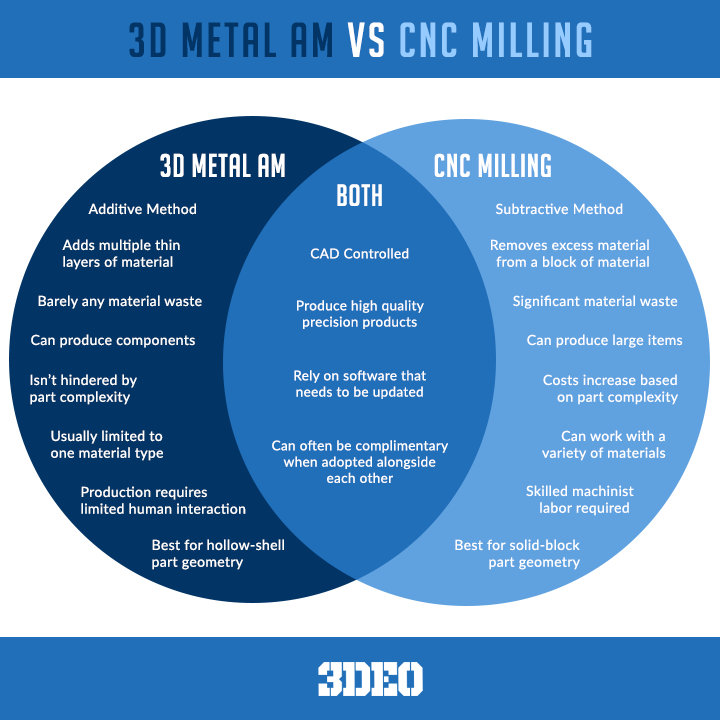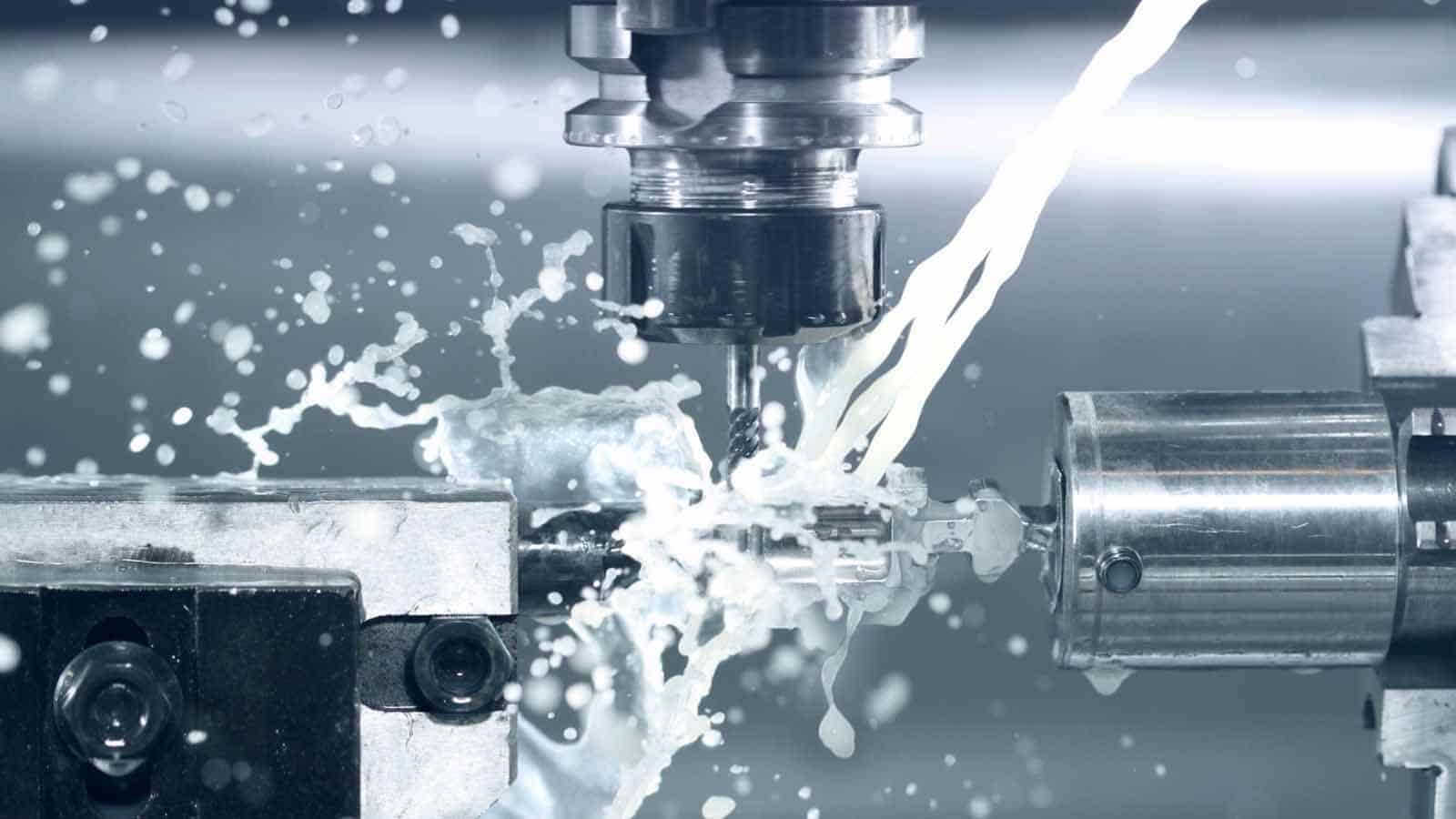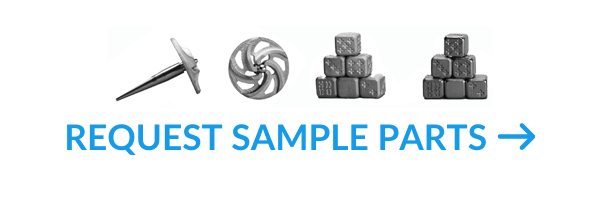Cost per part is only one aspect of the economics involved in CNC Milling and metal additive manufacturing technologies. At its core, the decision to choose CNC or AM (or both) comes down to part requirements within a specific application.
If you’ve been researching solutions for metal parts manufacturing, you’ve probably encountered the “either-or” scenario: either metal additive manufacturing (AM) is the best option or CNC milling can’t be beat.
Maybe there’s a middle ground as we explore the economics of each part-production method.
CNC Milling and 3D Printing Process Similarities and Differences
The inherent differences between the approaches to parts manufacturing makes getting a true apples-to-apples cost per part challenging, to say the least.
At a high level, we find a point of agreement between the two technologies: both CNC and AM processes are CAD-controlled and can produce high-quality, precision products. Additionally, both methods require equipment maintenance: for example, both rely on software that needs to be updated. CNC machines require new cutting tools and occasional mill replacement, and, yes, AM machines have an assortment of mechanical parts and nozzle heads that require cleaning and upkeep.
But the similarities end there.
Traditional CNC machining essentially whittles down a block of material using rotating cutters to remove excess material until the final geometry is achieved – a little like sculpting a statue from marble. The process tends to create more material waste and is known as a subtractive method. CNC routers can adapt to large and small end products, so they can produce larger items than current AM technologies. In terms of build time, CNC typically produces high volumes of product faster than additive manufacturing in most cases.
The costs of CNC milling increase based on the complexity of the part. Certain designs require changing tool-cutting sizes or tool paths, and that requires interruption in the production and additional labor cost – unlike parts produced in AM where the 3D printing process isn’t stymied by part complexity.
Most additive manufacturing techniques create final products using multiple layers of material, ranging from .05 mm – .33 mm in each layer, depending on the material and specific 3D printing technology application. Today’s 3D printer technology still faces end-product physical dimension limitations. In other words, it makes sense for the production of components but still isn’t ready to print standalone large products.
One example is direct metal laser sintering (DMLS) in which layers of metal powder are fused to form solid metal objects. Typically DMLS and other powder bed additive manufacturing techniques are a good choice for highly detailed parts or in situations where designs will undergo frequent modifications.
CNC and 3D Printer Material Options
A single CNC machine can work with a variety of materials, including a range of metal alloys, plastic, wax, and both hard and soft wood. In contrast, a single 3D printer tends to be limited to one material type, like a metal or a thermoplastic or a resin.
Additive manufacturing is closing the material gap every day with new materials and processes entering the market (like Nerdgasm’s wooden box video), so AM’s critical infrastructure will continue to evolve – and fast.
Acceptance of AM as a cost-effective production option is creating its own momentum. Demand is growing, and a lot of creative people are putting their considerable talents into improving 3D printing’s capabilities. In fact, the increasing adoption of metal AM is spurring reduction in raw material cost through economies of scale.
CNC Labor Costs: The Human Touch
A University of Berkeley research study compared the processes using a sample prototype. In the Computer Numerical Control (CNC) method, a skilled machinist spent several hours creating the prototype on a CNC mill, but in the metal AM method, the human touch was literally just a few clicks of a mouse. Theoretically, no constant human presence is required to oversee batch runs in the AM process, thereby reducing the skilled labor hours required in CNC.
Stronger Together? CNC and AM
To quote a National Institute of Standards and Technology (NIST) analysis, CNC milling and 3D printing technologies don’t need to be an either/or proposition:
“They can often be complementary, where two technologies are adopted alongside each other and the benefits are greater than if they were adopted individually.”
Long story short: CNC mills create more material waste, but some part geometries are more efficient to machine than to 3D print: for example, producing high volumes of solid-block geometry can reduce the cost per part, but for low volume production or hollow-shell part geometry, metal AM takes the ribbon.
Is Metal Injection Molding AM’s Ticket to Lowest Cost Per Part?
Advances in the metal injection molding process (MIM) are rapidly bringing down the cost-per-part price and allowing for high-volume production within the AM model. MIM combines finely powdered metal with a binder material for injection into a mold. Then the parts are furnace sintered to solidify the metal. This process allows for the high-volume production of complex parts, making MIM an ideal option for companies that need to produce hundreds or thousands of parts, where the efficiency of scale kicks in to offset the initial cost of the molding process.
But what if there were an even better way to produce large runs of high-quality, precision parts with the lowest price per part in the industry?
3DEO’s Intelligent Layering®: Breaking the Mold of Price Per Part
Welcome to the brave new world of large-scale additive manufacturing.
3DEO’s revolutionary new 3DEO’s Intelligent Layering® additive manufacturing technology builds parts using a thin layer of fine metal powder that is spread over the build area. Then a binder agent is applied to the entire layer. A cutter then shapes the perimeter of the part before the next layer of powder is spread and the build steps are repeated before sintering and finishing.
Intelligent Layering® can reduce the price per part by as much as 80 percent compared to other production options – and reducing costs is something everyone can agree on.
Contact 3DEO today to learn how our process can cut your parts cost.




